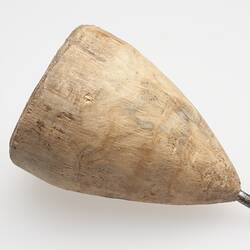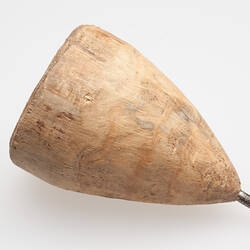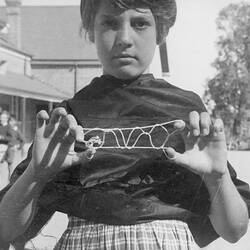Summary
Wooden spinning top made by Marcello D'Amico in 1954 in small village on the island of Stromboli, Italy when he was fourteen years old. Marcello's father was a builder so he had access to tools and supplies. He made the top using local hard wood and used a chisel to shape the wood then rubbed it down with a rasp to smooth it. A nail was then hammered into the pointed end of the top. Spinning was mainly a boys' game, with boys starting at seven or eight years old and continuing until their adult years.
To spin the top, the donor would wrap string around the nail and throw it. Several games were associated with top-spinning. One could pick up the top let it spin in one's hand. Tops could be transferred hand-to-hand. One could thrown one's top onto another top in order to split it. Tops could be thrown underhanded or overhanded, though the latter was more difficult. Tops were often marked with individual decorations, so that they could be recognised by their owners. As there were mass-produced consumer goods and popular cultural entertainment was slow to reach Marcello's home village on Stromboli, hand-made forms of recreation were still very popular in the 1950s. Marcello brought to Australia with him when he migrated in 1955 as a keepsake of his childhood. Marcello D'Amico was an artist and was involved in setting up the Centro Italiano D'Arte in 1962.
Physical Description
Wooden spinning top carved crudely from wood with metal nail inserted into tapered end. Coloured (chalk?) circles drawn on broad end of top.
More Information
-
Collection Names
Australian Children's Folklore Collection, Museums Victoria/Italian Historical Society Co.As.It Collection
-
Collecting Areas
-
Acquisition Information
Donation from Mr Marcello D'Amico, 2006
-
Maker
-
Classification
-
Category
-
Discipline
-
Type of item
-
Overall Dimensions
54 mm (Width), 93 mm (Height)
-
Keywords
Brought Goods, Immigration, Italian Communities, Italian Immigration, Tops, Toys, Making History - Australian Childrens Folklore



